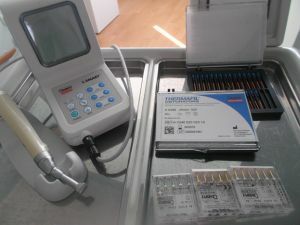 It is common for the root canal of the tooth to have a large number of branches, the so-called microchannels. If during the filling process at least one channel branch remains unfilled, it can lead to the development of an inflammatory process.
It is common for the root canal of the tooth to have a large number of branches, the so-called microchannels. If during the filling process at least one channel branch remains unfilled, it can lead to the development of an inflammatory process.
The result of such a complication can be a complete tooth loss. For a quality sealing, a completely new Thermophil system was developed using softened gutta percha.
Contents of
- What is it?
- General principles of
- procedure Sealing steps
- Correct determination of hole depth
- Correctness of machining
- Advantages and disadvantages of
- When is the most effective method?
What is it?
The Thermafil system is a new method of dental treatment, used for effective filling of tooth channels. For this, a heated gutta percha is used on a plastic carrier - obturator.
Today it is the most effective system for filling a channel with a three-dimensional obturation and a complete hermetic sealing of apex. This method of treatment significantly reduces the time of work of a specialist and guarantees high-quality sealing. Even the narrowest, curved canals can be reliably filled with filling material.
General principles of the
method This filling method was developed by Professor B. Johnson. Initially, metal rods covered with a primary gutta-percha layer were used as a carrier. Over time, the system has been improved and is now widely used in 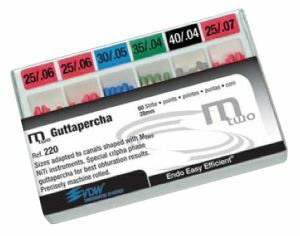 dentistry.
dentistry.
Thermophile consists of a rigid plastic obturator, which is covered with a layer of gutta percha. For ease of use, the rods come in different thicknesses and tapers. On each of them there are labels that allow you to control the depth of administration.
Gutta-percha, when heated, acquires good stickiness, due to which it is perfectly held on the rod, and then directly in the channel. Due to the fact that Thermafil has a plastic carrier, shrinkage of the material is prevented.
The procedure for use is as follows:
- the plastic core is processed with a heated gutta-percha;
- pin is inserted slowly into the channel by slow movements;
- being under pressure, the gutta percha tightly fills all available branches and the rest of the channel's volume.
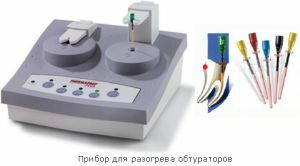 This procedure for performing the procedure due to tight sealing of the entire root system has received its second name - bulk filling.
This procedure for performing the procedure due to tight sealing of the entire root system has received its second name - bulk filling.
After carrying out such treatment, the danger of possible development of pathogenic microorganisms inside the tooth is significantly reduced.
The use of the Thermophile system makes it possible to use fewer composite materials with toxicity. Thus, the pain is reduced after tooth treatment.
The method requires considerable financial expenses for the acquisition of the following tools:
- drill with a special endodontic nozzle;
- furnaces for heating gutta-percha;
- endodontic instruments, most of which are expensive, and can only be applied several times.
All of the above explains why this convenient and simple treatment procedure is not offered in all clinics, mainly in private institutions.
Sealing steps
The filling of the canal with Thermophile occurs in several stages:
- the pulp is removed from the root space;
- channel opening widens;
- of the cavity obtained is cone shaped;
- , all infected dentin is removed from the cavity walls;
- with the help of a special device apex locator determines the depth of the hole;
- the channel cavity is several times subjected to antiseptic treatment;
- the entire canal cavity is washed with Chlorhexidine;
- channel clearance is thoroughly dried;
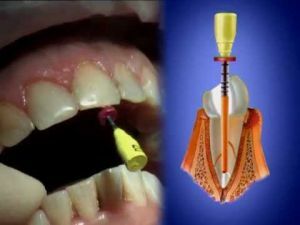
- introduction of the power unit;
- introduction of a plastic carrier;
- full lumen filling;
- removal of excess material;
- condensation of gutta percha in the canal mouth;
- Radiography of the sealed tooth to confirm the quality of filling the hole;
- antiseptic treatment of the oral cavity after treatment.
Several key factors affect the quality of the filling.
Correct determination of the depth of the hole
This technique involves filling the gutta-percha of the entire tooth with a channel opening and all its branches. In case of incomplete sealing, a pathogenic microflora begins to develop inside the tooth. The main reason for poor-quality filling is the error in measuring the depth of the hole. Such treatment can lead to the following complications:
- development of inflammation, cyst formation, periodontitis, - in the absence of proper treatment, the tooth will have to be removed;
- appearance of severe pain, which will pass into neuralgia.
During the determination of the depth of the hole, a tooth snapshot should be taken. So you can be sure that the measuring tool reaches to the bottom.
Correctness of machining
It is carried out for a sufficient expansion of the channel opening, removal of all surface defects and irregularities. Sealing unprocessed canals is difficult because of their narrow size and curvature.
Advantages and disadvantages of
Among the main advantages of the system, the following advantages are worth noting:
- guarantee of high-efficiency sealed sealing;
- risk of developing an inflammatory process is unlikely;
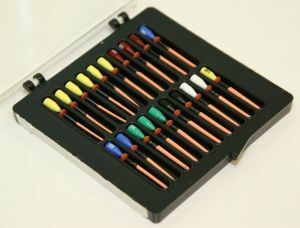
- material has a low level of toxicity;
- apical integrity;
- possibility to control the depth of the insertion of the pins;
- , if necessary, repeat the treatment, the rod is easily removed from the root hole;
- for the qualitative filling of cavities does not matter the curvature of the roots;
- after the treatment there are no painful sensations.
Thermoplastic gutta percha is a safe material. But among a large number of advantages, one major drawback of the material can be noted - a slight shrinkage after curing.
When is the method most effective?
The application of the system is most effective in the following cases:
- with infectious lesions of the dental root system;
- when removal of inflamed pulp is required;
- in case of strong curvature of channel branches and the channel itself;
- with initial root canal failure;
- for shaping the cavity before filling;
- direct installation of the seal.
The most difficult case is the need to treat a tooth that has already been sealed, if the holes have been filled poorly. In this case, the three-dimensional filling is also at a height.
There have been many clinical studies that have proven the effectiveness of the Thermophil system. With its help, it is possible to conduct a reliable hermetic sealing of the channel cavity with the preservation of the result for many years to come.
